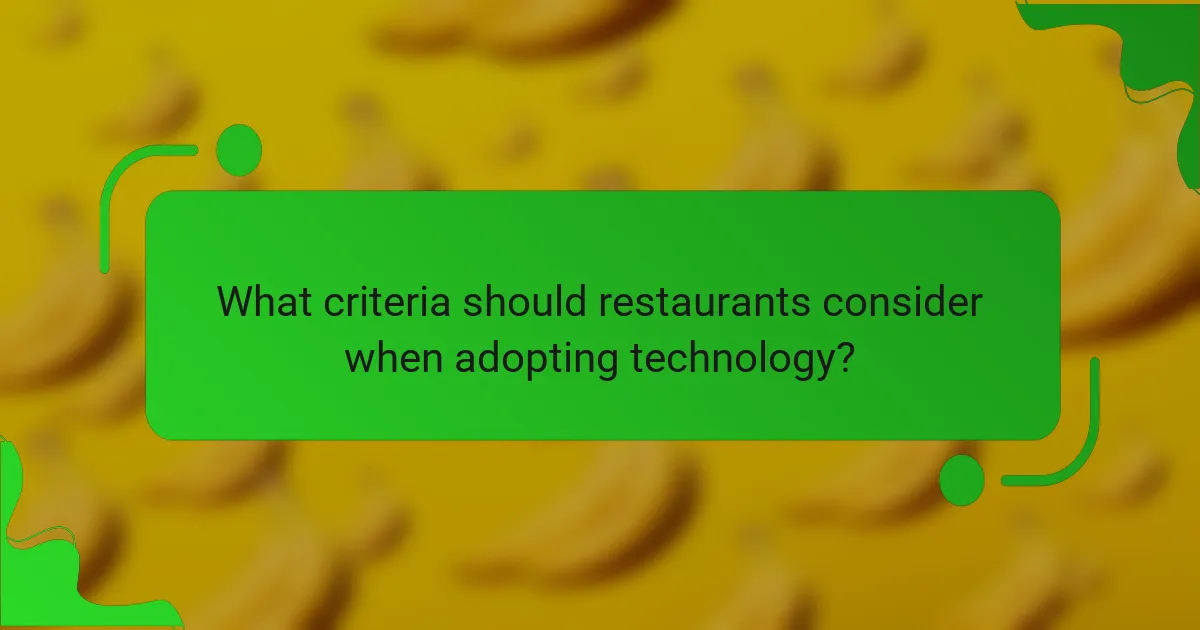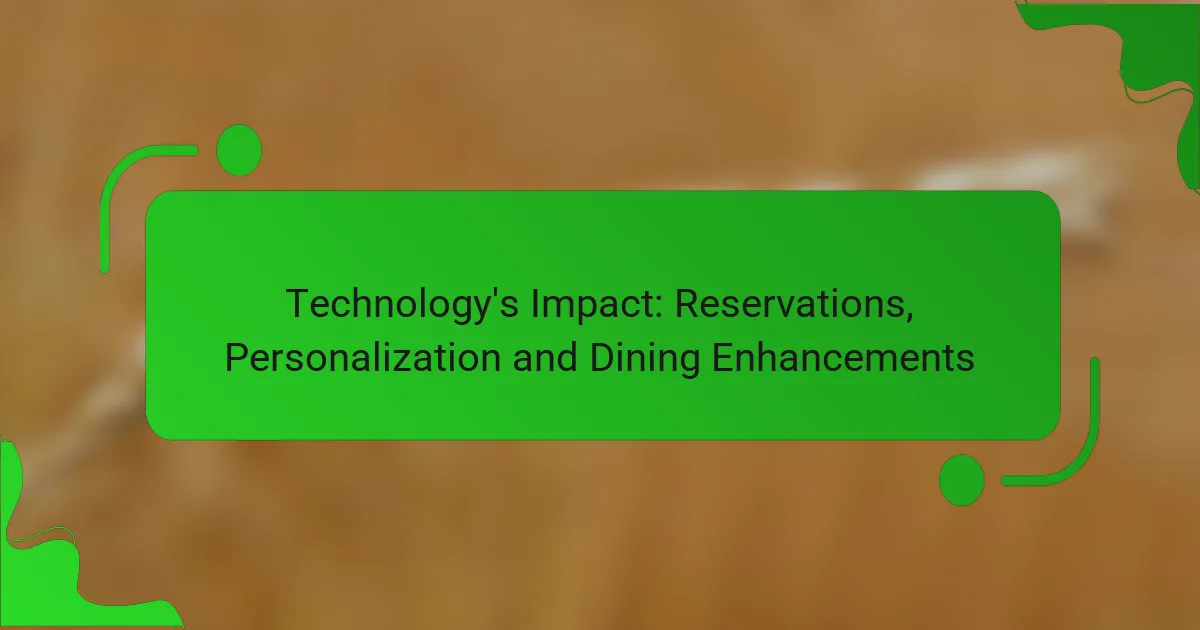Technology is revolutionizing the dining experience by enhancing restaurant reservations, personalizing services, and streamlining operations. With online booking systems and mobile apps, diners can easily secure tables, while restaurants benefit from improved seating management. Additionally, personalized features such as customized menu recommendations and loyalty programs cater to individual preferences, creating a more engaging experience for customers.

How is technology enhancing reservations in restaurants?
Technology is significantly enhancing restaurant reservations by streamlining the booking process, improving customer experience, and increasing operational efficiency. With tools like online booking systems and mobile reservation apps, diners can secure tables quickly and conveniently, while restaurants can manage their seating more effectively.
Online booking systems
Online booking systems allow customers to make reservations directly through a restaurant’s website or third-party platforms. These systems often include features such as customizable booking forms, automated confirmation emails, and the ability to manage reservations in real-time. Popular platforms like OpenTable and Resy have become industry standards, enabling restaurants to handle high volumes of bookings seamlessly.
When choosing an online booking system, consider factors like user interface, integration with existing restaurant management software, and customer support. A well-implemented system can reduce no-shows and enhance customer satisfaction by providing a straightforward reservation experience.
Mobile reservation apps
Mobile reservation apps have transformed how diners book tables, offering convenience at their fingertips. Apps like Yelp Reservations and Bookatable allow users to search for restaurants, view menus, and make reservations from their smartphones. This accessibility caters to the growing trend of mobile-first consumers who prefer to manage their dining plans on the go.
To maximize the benefits of mobile reservation apps, restaurants should ensure their profiles are up-to-date with accurate information and engaging visuals. Encouraging customers to download these apps can also foster loyalty and repeat business.
Real-time table availability
Real-time table availability features enable diners to see which tables are open at any given moment, enhancing the booking experience. This technology often integrates with online booking systems, allowing customers to select their preferred time slots based on current availability. This transparency can lead to higher conversion rates as diners can make informed decisions quickly.
Restaurants should consider implementing real-time availability tools to minimize wait times and improve customer satisfaction. It’s essential to ensure that the system is regularly updated to reflect accurate availability, preventing overbooking and enhancing operational efficiency.

What personalization features are available in dining experiences?
Personalization features in dining experiences enhance customer satisfaction by tailoring offerings to individual preferences. These features include customized menu recommendations, loyalty program integration, and dietary preference tracking, all aimed at creating a more engaging and relevant dining experience.
Customized menu recommendations
Customized menu recommendations utilize data from previous orders, customer preferences, and even seasonal ingredients to suggest dishes that align with individual tastes. For instance, a diner who frequently orders vegetarian meals may receive suggestions for new plant-based options or seasonal specials that fit their diet.
Restaurants often implement algorithms that analyze customer behavior, allowing them to present personalized choices right when a customer views the menu. This not only enhances the dining experience but can also increase sales by promoting items that customers are more likely to enjoy.
Loyalty programs integration
Loyalty programs integration allows diners to earn rewards based on their spending and frequency of visits. These programs can be personalized, offering tailored rewards such as discounts on favorite dishes or exclusive access to special events based on a customer’s dining history.
For example, a restaurant might offer a free dessert after a certain number of visits or provide a birthday discount. This not only encourages repeat business but also fosters a sense of belonging and appreciation among loyal customers.
Dietary preference tracking
Dietary preference tracking enables restaurants to keep records of customer allergies, dietary restrictions, and preferences. This feature ensures that diners receive safe and enjoyable meal options, which is particularly important for those with food sensitivities or specific lifestyle choices.
By allowing customers to update their preferences through an app or website, restaurants can proactively suggest suitable meals. This not only enhances customer trust but also reduces the risk of serving inappropriate dishes, ultimately leading to a more satisfying dining experience.

How does technology improve dining enhancements?
Technology enhances dining experiences by streamlining processes, personalizing services, and improving customer satisfaction. Innovations like contactless payments, augmented reality menus, and smart table technology transform how diners interact with restaurants.
Contactless payment systems
Contactless payment systems allow customers to settle their bills quickly and securely using mobile devices or contactless cards. This technology reduces wait times and enhances convenience, making it easier for diners to pay without handling cash or waiting for a server.
Restaurants adopting these systems often see increased table turnover rates, as payments can be completed in seconds. It’s essential to ensure that the payment systems comply with local regulations and security standards to protect customer data.
Augmented reality menus
Augmented reality (AR) menus provide an interactive dining experience by allowing customers to visualize dishes before ordering. Using a smartphone or tablet, diners can see 3D representations of menu items, helping them make informed choices based on appearance and portion size.
Implementing AR menus can differentiate a restaurant in a competitive market. However, it requires investment in technology and content creation, so restaurants should weigh the potential benefits against the costs involved.
Smart table technology
Smart table technology enhances the dining experience by integrating features like touchscreens for ordering, built-in charging ports, and even entertainment options. These tables can streamline the ordering process, allowing diners to customize their meals and request service without waiting for a server.
While smart tables can improve efficiency and customer engagement, they also require regular maintenance and updates. Restaurants should consider the initial investment and ongoing costs to ensure that the technology remains functional and appealing to customers.

What are the benefits of using technology in local dining?
Technology in local dining enhances the overall experience for both customers and restaurant operators. It streamlines processes, improves personalization, and fosters stronger connections between diners and establishments.
Increased customer satisfaction
Implementing technology in dining can significantly boost customer satisfaction by providing convenience and tailored experiences. For instance, mobile apps allow diners to place orders ahead of time, reducing wait times and ensuring their preferences are met.
Additionally, features like digital menus and loyalty programs can enhance the dining experience, making it easier for customers to explore options and receive rewards. Restaurants that utilize these technologies often see higher repeat business and positive reviews.
Operational efficiency
Technology improves operational efficiency by automating tasks and optimizing workflows. Point-of-sale systems can streamline order processing, inventory management, and payment handling, allowing staff to focus on customer service rather than administrative duties.
Moreover, data analytics can help restaurants identify peak hours and popular menu items, enabling better staffing and inventory decisions. This leads to reduced waste and improved profitability, making it essential for local dining establishments to adopt such tools.
Enhanced customer engagement
Engaging customers through technology fosters loyalty and community. Social media platforms and email marketing allow restaurants to communicate directly with diners, sharing updates, promotions, and personalized offers based on past behavior.
Furthermore, interactive dining experiences, such as virtual reality menus or gamified loyalty programs, can create memorable moments that encourage customers to return. Establishments that prioritize engagement through technology often cultivate a dedicated customer base, essential for long-term success.

What criteria should restaurants consider when adopting technology?
Restaurants should evaluate budget constraints, staff training requirements, and customer demographics when adopting technology. These factors significantly influence the successful integration of tech solutions that enhance operations and customer experiences.
Budget constraints
Budget constraints are a primary consideration for restaurants looking to adopt new technology. Establishments should assess both initial investment costs and ongoing expenses, such as maintenance and software subscriptions. A clear budget helps prioritize which technologies can deliver the best return on investment.
For example, a restaurant might consider implementing a reservation system that costs around $100 to $300 per month, depending on features. Alternatively, investing in a more comprehensive point-of-sale system could range from a few hundred to several thousand dollars, depending on the scale and capabilities.
Staff training requirements
Staff training requirements are crucial when integrating new technology into restaurant operations. Employees must be comfortable and proficient with the technology to ensure smooth implementation and customer satisfaction. Training programs should be factored into the overall budget and timeline for technology adoption.
Consider offering hands-on training sessions or online tutorials to help staff adapt. A well-trained team can reduce errors and improve efficiency, leading to a better dining experience for customers.
Customer demographics
Understanding customer demographics is essential for selecting technology that resonates with patrons. Different age groups and cultures may have varying preferences for digital interactions, such as mobile ordering or online reservations. Tailoring technology to meet these preferences can enhance customer engagement.
For instance, a restaurant in a tech-savvy urban area might benefit from a robust mobile app, while a family-oriented establishment may focus on user-friendly online booking systems. Gathering feedback from customers can also guide technology choices that align with their needs and expectations.



